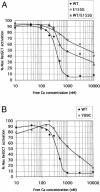Identification and functional consequences of a new mutation (E155G) in the gene for GCAP1 that causes autosomal dominant cone dystrophy
- PMID: 11484154
- PMCID: PMC1235478
- DOI: 10.1086/323265
Identification and functional consequences of a new mutation (E155G) in the gene for GCAP1 that causes autosomal dominant cone dystrophy
Abstract
Mutations in the gene for guanylate cyclase-activating protein-1 (GCAP1) (GUCA1A) have been associated with autosomal dominant cone dystrophy (COD3). In the present study, a severe disease phenotype in a large white family was initially shown to map to chromosome 6p21.1, the location of GUCA1A. Subsequent single-stranded conformation polymorphism analysis and direct sequencing revealed an A464G transition, causing an E155G substitution within the EF4 domain of GCAP1. Modeling of the protein structure shows that the mutation eliminates a bidentate amino acid side chain essential for Ca2+ binding. This represents the first disease-associated mutation in GCAP1, or any neuron-specific calcium-binding protein within an EF-hand domain, that directly coordinates Ca2+. The functional consequences of this substitution were investigated in an in vitro assay of retinal guanylate cyclase activation. The mutant protein activates the cyclase at low Ca2+ concentrations but fails to inactivate at high Ca2+ concentrations. The overall effect of this would be the constitutive activation of guanylate cyclase in photoreceptors, even at the high Ca2+ concentrations of the dark-adapted state, which may explain the dominant disease phenotype.
Figures






Similar articles
-
Autosomal dominant cone dystrophy caused by a novel mutation in the GCAP1 gene (GUCA1A).Mol Vis. 2005 Feb 20;11:143-51. Mol Vis. 2005. PMID: 15735604
-
A novel mutation (I143NT) in guanylate cyclase-activating protein 1 (GCAP1) associated with autosomal dominant cone degeneration.Invest Ophthalmol Vis Sci. 2004 Nov;45(11):3863-70. doi: 10.1167/iovs.04-0590. Invest Ophthalmol Vis Sci. 2004. PMID: 15505030 Free PMC article.
-
A mutation in guanylate cyclase activator 1A (GUCA1A) in an autosomal dominant cone dystrophy pedigree mapping to a new locus on chromosome 6p21.1.Hum Mol Genet. 1998 Feb;7(2):273-7. doi: 10.1093/hmg/7.2.273. Hum Mol Genet. 1998. PMID: 9425234
-
Guanylate cyclase activating proteins, guanylate cyclase and disease.Adv Exp Med Biol. 2002;514:411-38. doi: 10.1007/978-1-4615-0121-3_25. Adv Exp Med Biol. 2002. PMID: 12596936 Review.
-
GCAP1 mutations associated with autosomal dominant cone dystrophy.Adv Exp Med Biol. 2010;664:273-82. doi: 10.1007/978-1-4419-1399-9_31. Adv Exp Med Biol. 2010. PMID: 20238026 Free PMC article. Review.
Cited by
-
RNAi-mediated gene suppression in a GCAP1(L151F) cone-rod dystrophy mouse model.PLoS One. 2013;8(3):e57676. doi: 10.1371/journal.pone.0057676. Epub 2013 Mar 5. PLoS One. 2013. PMID: 23472098 Free PMC article.
-
Guanylate cyclases and associated activator proteins in retinal disease.Mol Cell Biochem. 2010 Jan;334(1-2):157-68. doi: 10.1007/s11010-009-0331-y. Epub 2009 Nov 26. Mol Cell Biochem. 2010. PMID: 19941038 Review.
-
Identification of target binding site in photoreceptor guanylyl cyclase-activating protein 1 (GCAP1).J Biol Chem. 2014 Apr 4;289(14):10140-54. doi: 10.1074/jbc.M113.540716. Epub 2014 Feb 24. J Biol Chem. 2014. PMID: 24567338 Free PMC article.
-
Functional EF-hands in neuronal calcium sensor GCAP2 determine its phosphorylation state and subcellular distribution in vivo, and are essential for photoreceptor cell integrity.PLoS Genet. 2014 Jul 24;10(7):e1004480. doi: 10.1371/journal.pgen.1004480. eCollection 2014 Jul. PLoS Genet. 2014. PMID: 25058152 Free PMC article.
-
Retinal guanylyl cyclase activating protein 1 forms a functional dimer.PLoS One. 2018 Mar 7;13(3):e0193947. doi: 10.1371/journal.pone.0193947. eCollection 2018. PLoS One. 2018. PMID: 29513743 Free PMC article.
References
Electronic-Database Information
-
- Online Mendelian Inheritance in Man (OMIM), http://www.ncbi.nlm.nih.gov/Omim (for autosomal dominant retinal cone dystrophy, COD3, and GCAP1 [OMIM 180020, 602093, and 600364])
-
- Swiss-Model, http://www.expasy.ch/swissmod/SWISS-MODEL.html (for protein modeling)
References
-
- Balciuniene J, Johanssen K, Sandgren O, Wachmeister L, Homgren G, Forsman G (1995) A gene for autosomal dominant progressive cone dystrophy (CORD5) maps to chromosome 17p12-p13. Genomics 30:281–286 - PubMed
-
- Cuenca N, Lopez S, Howes K, Kolb H (1998) The localization of guanylyl cyclase-activating proteins in the mammalian retina. Invest Ophthalmol Vis Sci 39:1243–1250 - PubMed
-
- Dizhoor AM, Boikov SG, Olshevskaya EV (1998) Constitutive activation of photoreceptor guanylate cyclase by Y99C mutant of GCAP-1. J Biol Chem 273:17311–17314 - PubMed
-
- Dizhoor AM, Hurley JB (1999) Regulation of photoreceptor membrane guanylate cyclases by guanylate cyclase activator proteins. Methods 19:521–531 - PubMed
Publication types
MeSH terms
Substances
Associated data
- Actions
- Actions
- Actions
Grants and funding
LinkOut - more resources
Full Text Sources
Molecular Biology Databases
Research Materials
Miscellaneous

